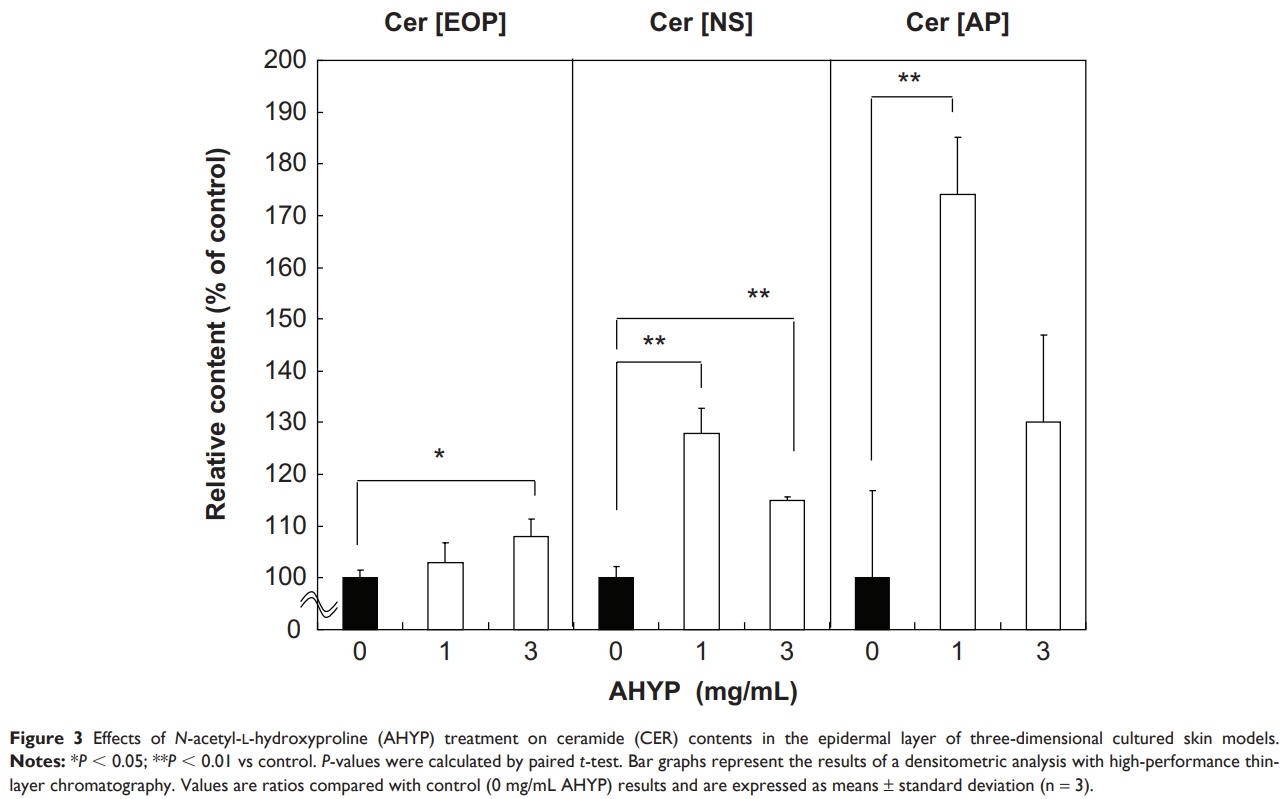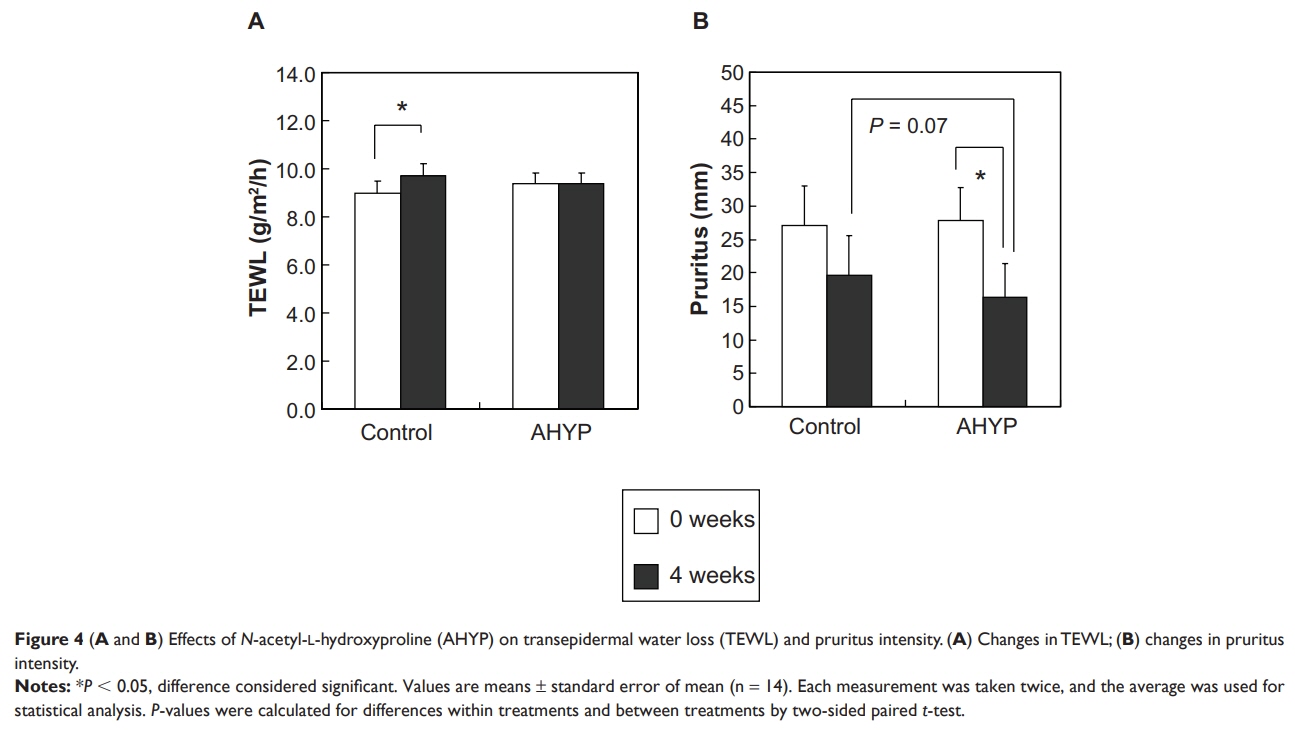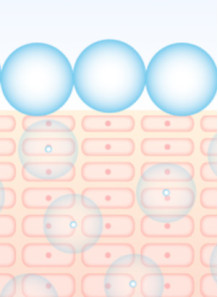N-Acetyl-L-Hydroxyproline (Acetyl Hydroxyproline)
- Product Code: 8111
Derivatives of amino acids with research results that it can stimulate collagen synthesis and stimulates the synthesis of ceramide in the skin well
- -
- -
- -
- -
- -
- -
- -
- -
- -
- -
- -
- -
- -
- -
- -
- -
- -
- -
| Test Name | Specification |
|---|---|
| Appearance | white to off-white powder |
| Odor | Slight characteristics |
| Purity (HPLC-DAD, %) | 98.5 Min |
| Content (Acetyl Hydroxyproline, %) | 98.5 Min |
| Specification Rotation [a]20D | -115 to -127 |
| Loss on drying (%) | 0.5 Max |
| Residue on ignition (%) | 0.2 Max |
| pH (2% aqueous solution, 25C) | 1.5-2.5 |
N-Acetyl-L-Hydroxyproline (Acetyl Hydroxyproline) is a derivative of amino acid that has research results. that it can stimulate collagen synthesis and stimulates the synthesis of ceramide in the skin well

From the 4-week experiment, it was found that N-Acetyl-L-Hydroxyproline Can stimulate the synthesis of ceramides in the skin well.

From the 4-week experiment, it was found that N-Acetyl-L-Hydroxyproline Can reduce water loss from the skin. and reduces itching of the skin (pruritus intensity) well
Please study additional information about the research in the attached document (Topical effects of N-acetyl-L-hydroxyproline on ceramide synthesis and alleviation of pruritus).
Instructions for mixing
1. The formula should have a pH in the range of 4-10, not lower than this. When mixing Acetyl Hydroxyproline, the pH of the formula will decrease (pH value at 1% of Acetyl Hydroxyproline in water will be in the range 1.4-2.5). This requires adjusting the pH value up so that Acetyl Hydroxyproline does not lose its quality.
2. Recommend using a buffer such as HEPES or using a weak alkali such as Triethanolamine to help adjust the pH of the formula.
Usage: Can be used in all types of Anti-Aging products, such as in the form of gels, serums, lotions, or creams.
Mixing method: Mix in the final step. The temperature of the cosmetics must be lower than 40 °C. The pH of the formula should be in the range pH 4-10.
Usage rate: 1%
Product appearance: white powder
Solubility: Can dissolve in water
Storage: Store in the refrigerator at 4 °C -8 °C. 24 months old
INCI Name : Acetyl Hydroxyproline
Examples of products using Acetyl Hydroxyproline
ARTISTRY Youth Xtend™ Enriching Eye Cream
ARTISTRY Youth Xtend™ Enriching Cream
ARTISTRY™ Advanced Creamy Foam Cleanser
Kose cosmeport Jelaime Amino Deep Repair Algae Mask
La Prairie Cellular Radiance Perfecting Fluide Pure Gold
NeoStrata Skin Active Firming Collagen Booster
StriVectin-SD Power Serum
Laura Mercier Perfecting Water
Dr.Ci:Labo Aqua-collagen-gel BI.HA.Ku
Be the first to review this product :-)
Example recipes using this ingredient:
- › lock_outlineActiv ING 0.3
- › lock_outlineActiv ING 0.4
- › lock_outlineActiv ING 0.6
- › lock_outlineSkin Serum
Recommend Lab-Service
| Lab Service | Price |
|---|
Derivatives of amino acids with research results that it can stimulate collagen synthesis and stimulates the synthesis of ceramide in the skin well
N-Acetyl-L-Hydroxyproline (Acetyl Hydroxyproline) is a derivative of amino acid that has research results. that it can stimulate collagen synthesis and stimulates the synthesis of ceramide in the skin well

From the 4-week experiment, it was found that N-Acetyl-L-Hydroxyproline Can stimulate the synthesis of ceramides in the skin well.

From the 4-week experiment, it was found that N-Acetyl-L-Hydroxyproline Can reduce water loss from the skin. and reduces itching of the skin (pruritus intensity) well
Please study additional information about the research in the attached document (Topical effects of N-acetyl-L-hydroxyproline on ceramide synthesis and alleviation of pruritus).
Instructions for mixing
1. The formula should have a pH in the range of 4-10, not lower than this. When mixing Acetyl Hydroxyproline, the pH of the formula will decrease (pH value at 1% of Acetyl Hydroxyproline in water will be in the range 1.4-2.5). This requires adjusting the pH value up so that Acetyl Hydroxyproline does not lose its quality.
2. Recommend using a buffer such as HEPES or using a weak alkali such as Triethanolamine to help adjust the pH of the formula.
Usage: Can be used in all types of Anti-Aging products, such as in the form of gels, serums, lotions, or creams.
Mixing method: Mix in the final step. The temperature of the cosmetics must be lower than 40 °C. The pH of the formula should be in the range pH 4-10.
Usage rate: 1%
Product appearance: white powder
Solubility: Can dissolve in water
Storage: Store in the refrigerator at 4 °C -8 °C. 24 months old
INCI Name : Acetyl Hydroxyproline
Examples of products using Acetyl Hydroxyproline
ARTISTRY Youth Xtend™ Enriching Eye Cream
ARTISTRY Youth Xtend™ Enriching Cream
ARTISTRY™ Advanced Creamy Foam Cleanser
Kose cosmeport Jelaime Amino Deep Repair Algae Mask
La Prairie Cellular Radiance Perfecting Fluide Pure Gold
NeoStrata Skin Active Firming Collagen Booster
StriVectin-SD Power Serum
Laura Mercier Perfecting Water
Dr.Ci:Labo Aqua-collagen-gel BI.HA.Ku
| Mechanism | - |
| Appearance | - |
| Longevity | - |
| Strength | - |
| Storage | - |
| Shelf Life | - |
| Allergen(s) | - |
| Dosage (Range) | - |
| Recommended Dosage | - |
| Dosage (Per Day) | - |
| Recommended Dosage (Per Day) | - |
| Mix Method | - |
| Heat Resistance | - |
| Stable in pH range | - |
| Solubility | - |
| Product Types | - |
| INCI | - |
Cart
No products



